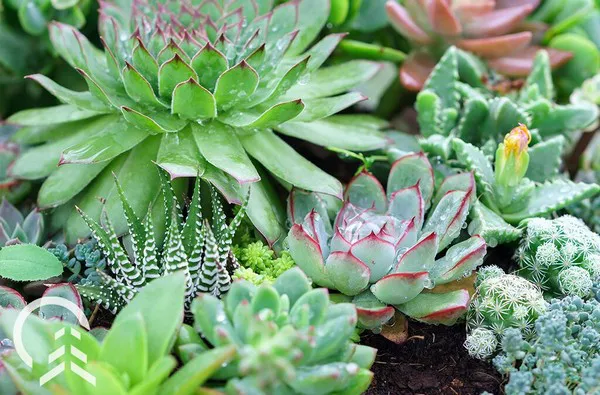Succulents have captured the hearts of plant enthusiasts worldwide, thanks to their unique shapes, colors, and resilience. With a remarkable variety of species and hybrids, succulents offer endless possibilities for both indoor and outdoor gardens.
Defining Succulents
Succulents, characterized by their ability to store water in thickened, fleshy leaves, stems, or roots, are a diverse group of plants adapted to arid and semi-arid environments. The term “succulent” is derived from the Latin word “sucus,” meaning sap or juice, highlighting the plant’s water-retaining capabilities. This adaptation allows succulents to survive in conditions where water is scarce, making them well-suited for various climates around the world.
Cacti: A Prickly Subset of Succulents
Cacti, a subgroup of succulents, are perhaps the most iconic and recognizable members of this plant family. Characterized by their spines and unique growth forms, cacti have evolved to thrive in some of the most challenging environments on Earth. While all cacti are succulents, not all succulents are cacti. The distinction lies in the presence of areolas, specialized structures from which spines, flowers, and new stems emerge. Cacti come in various shapes and sizes, from the towering Saguaro cactus (Carnegiea gigantea) of the American Southwest to the small and charming mammillaria species.
Sedum: The Versatile Stonecrop Succulents
Sedum, commonly known as stonecrop, is a large and diverse genus within the Crassulaceae family. These succulents are valued for their versatility and adaptability, making them popular choices for gardens, containers, and rockeries. With a vast array of species and cultivars, sedums offer a spectrum of colors, leaf shapes, and growth habits. From the ground-hugging Sedum acre to the upright Sedum spectabile, these succulents thrive in well-draining soil and prefer full sun but can tolerate partial shade.
Echeveria: Rosette Beauty Among Succulents
Echeveria, known for their stunning rosette formations, are prized for their symmetry and vibrant hues. These succulents belong to the Crassulaceae family and are native to Central America. Echeverias come in various sizes, ranging from small, compact rosettes to larger, more sprawling forms. Their thick, fleshy leaves contribute to water storage, allowing them to withstand dry conditions. Popular varieties include Echeveria ‘Lola’ with its lilac-pink tones and Echeveria ‘Doris Taylor,’ known for its fuzzy, velvety leaves.
Aloe: Soothing Succulents with Medicinal Properties
Aloe plants, recognized for their fleshy, lance-shaped leaves and gel-filled interiors, are not only aesthetically pleasing but also renowned for their medicinal properties. Aloe vera (Aloe barbadensis miller) is the most well-known species, celebrated for its gel, which is commonly used to soothe sunburns and skin irritations. Aloe plants thrive in arid conditions and are characterized by their rosette growth habit. While many species are green, some, like Aloe ‘Black Gem,’ boast dark and dramatic foliage.
Agave: Architectural Wonders of the Succulent World
Agave plants are architectural marvels among succulents, renowned for their symmetrical rosettes and often spiky, toothed leaves. These plants are well-adapted to arid regions and can vary greatly in size, from small, container-friendly varieties to colossal species like the Agave americana, also known as the century plant. Agaves are characterized by their dramatic, often sculptural forms, making them focal points in both outdoor landscapes and indoor collections.
Crassula: Diverse and Adaptable Succulents
Crassula, a large genus within the Crassulaceae family, encompasses a diverse array of succulents with different growth habits and leaf shapes. From the compact and popular Jade Plant (Crassula ovata) to the stacked and quirky Crassula perforata, these succulents are known for their resilience and adaptability. Some crassulas are suitable for bonsai cultivation, while others, like Crassula argentea ‘Gollum,’ feature distinctive tubular leaves that add a touch of whimsy to any succulent collection.
Haworthia: Windowed Wonders of the Succulent World
Haworthia, often referred to as “windowed succulents,” are prized for their translucent leaf tips, allowing sunlight to penetrate and create captivating patterns. These plants belong to the Asphodelaceae family and are native to Southern Africa. Haworthias come in various sizes, from small, compact rosettes to larger, more sprawling forms. The popular Haworthia attenuata, also known as the zebra plant, features striking white stripes on its dark green leaves.
Kalanchoe: Blossoming Beauties Among Succulents
Kalanchoe is a diverse genus that includes succulents prized for their vibrant, long-lasting flowers. These plants belong to the Crassulaceae family and are native to Madagascar and tropical Africa. Kalanchoes are known for their impressive blooms, which can range in color from fiery reds and oranges to soft pinks and whites. Kalanchoe blossfeldiana, commonly known as the flaming Katy, is a popular flowering succulent often seen in homes and gardens.
Senecio: Unique and Diverse Succulents
Senecio is a vast genus that includes a wide range of succulents with diverse growth habits and leaf shapes. From trailing varieties like Senecio rowleyanus, also known as the string of pearls, to upright forms like Senecio mandraliscae with its striking blue leaves, these succulents add unique textures and colors to succulent collections. Senecios are known for their adaptability and ability to thrive in various conditions.
Sempervivum: Hardy Hens and Chicks Succulents
Sempervivum, commonly known as hens and chicks, are hardy succulents characterized by their rosette growth habit and ability to produce offsets, or “chicks.” These plants belong to the Crassulaceae family and are well-suited for rock gardens, containers, and ground cover. Sempervivums come in a wide range of colors, with varieties like Sempervivum ‘Ruby Heart’ displaying rich red tones and Sempervivum ‘Green Wheel’ showcasing vibrant green hues.
Conclusion
The world of succulents is a vast and diverse one, offering a myriad of options for plant enthusiasts of all levels. From the iconic cacti to the delicate haworthias, succulents exhibit an incredible range of shapes, sizes, and colors. Understanding the unique characteristics and care requirements of each type of succulent is key to cultivating a thriving and visually stunning succulent collection. Whether you’re a seasoned succulent aficionado or a novice plant parent, the world of succulents invites exploration, creativity, and the joy of nurturing these fascinating and resilient plants.


